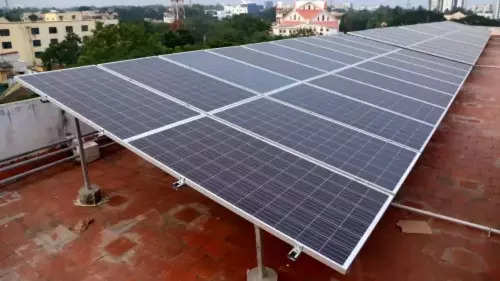An industry insider familiar with RIL’s strategy revealed, “RIL is preparing to commission its 5GW module manufacturing capacity by March 2024 and then scale it up to 10GW and then double it.” However, RIL has not responded to inquiries by ET.
The company’s solar PV and module factory will be based on REC technology. Through its subsidiary Reliance New Energy Solar, RIL secured full ownership of REC Solar, headquartered in Norway, in 2021 for $771 million (Rs 5800 crore).
RIL is concentrating on augmenting the efficiency of its modules, aiming to elevate the Heterojunction Technology (HJT) module efficiency from the present 23% to 26% by 2026. Further enhancements to 28% are being pursued, using innovations like perovskite-tandem cell technology. This information was conveyed in the company’s 2022-23 annual report, which also outlined ambitions to extend the longevity of PV modules from 25 to 50 years.
RIL has signed a supply contract with China-based Suzhou Maxwell Technologies for a high-efficiency production line for HJT cells with a 4.8GW capacity.
RIL’s long-term plan includes establishing 20GW of solar energy generation capacity by 2025, catering to round-the-clock power demands and sporadic energy necessities for green hydrogen production. The company has acquired a 74,750-hectare land parcel on a 40-year lease in Gujarat for its green hydrogen venture.
“Once proven at scale, Reliance is prepared to double the investment to scale up the manufacturing ecosystem,” affirmed RIL in its annual report. In 2021, the company disclosed an investment of Rs 75,000 crore for the development of its new energy business.
Major strides are being made in constructing the Dhirubhai Ambani Green Energy Giga Complex, sprawling over 5,000 acres in Jamnagar. This facility will facilitate the creation of photovoltaic panels, energy storage, green hydrogen production, and fuel cell systems. With a target of achieving 100GW of solar energy by 2030, RIL remains committed to these aspirations.
Under the Solar Production Linked Incentive (PLI) Scheme, RIL has been granted Integrated Solar Manufacturing rights for a 10GW yearly capacity, encompassing PolySilicon, Wafer, Cell, and Module production. Furthermore, the company has secured an ACC (Advanced Chemistry Cell) PLI Scheme for the annual manufacturing of batteries, with a capacity of 5GWh.
Additionally, RIL is constructing a Giga Factory for Power Electronics, intending to bridge the entire green energy value chain. This initiative will entail the development and production of affordable power electronics and software systems, achieved through global collaborations.
In its pursuit of integrated solar PV module capabilities, aside from REC, RIL has gained stakes in four entities over the past three years. These include a 40% stake in Sterling & Wilson Renewable Energy, a 20% interest in Caelux Corporation for advancing perovskite-based solar technology, a majority stake in SenseHawk, a California-based software tool developer for the solar energy sector, and a technology development partnership with Germany’s NexWafe.
!(function(f, b, e, v, n, t, s) {
function loadFBEvents(isFBCampaignActive) {
if (!isFBCampaignActive) {
return;
}
(function(f, b, e, v, n, t, s) {
if (f.fbq) return;
n = f.fbq = function() {
n.callMethod ? n.callMethod(…arguments) : n.queue.push(arguments);
};
if (!f._fbq) f._fbq = n;
n.push = n;
n.loaded = !0;
n.version = ‘2.0’;
n.queue = [];
t = b.createElement(e);
t.async = !0;
t.defer = !0;
t.src = v;
s = b.getElementsByTagName(e)[0];
s.parentNode.insertBefore(t, s);
})(f, b, e, ‘https://connect.facebook.net/en_US/fbevents.js’, n, t, s);
fbq(‘init’, ‘593671331875494’);
fbq(‘track’, ‘PageView’);
};
function loadGtagEvents(isGoogleCampaignActive) {
if (!isGoogleCampaignActive) {
return;
}
var id = document.getElementById(‘toi-plus-google-campaign’);
if (id) {
return;
}
(function(f, b, e, v, n, t, s) {
t = b.createElement(e);
t.async = !0;
t.defer = !0;
t.src = v;
t.id = ‘toi-plus-google-campaign’;
s = b.getElementsByTagName(e)[0];
s.parentNode.insertBefore(t, s);
})(f, b, e, ‘https://www.googletagmanager.com/gtag/js?id=AW-877820074’, n, t, s);
};
window.TimesApps = window.TimesApps || {};
var TimesApps = window.TimesApps;
TimesApps.toiPlusEvents = function(config) {
var isConfigAvailable = “toiplus_site_settings” in f && “isFBCampaignActive” in f.toiplus_site_settings && “isGoogleCampaignActive” in f.toiplus_site_settings;
var isPrimeUser = window.isPrime;
if (isConfigAvailable && !isPrimeUser) {
loadGtagEvents(f.toiplus_site_settings.isGoogleCampaignActive);
loadFBEvents(f.toiplus_site_settings.isFBCampaignActive);
} else {
var JarvisUrl=”https://jarvis.indiatimes.com/v1/feeds/toi_plus/site_settings/643526e21443833f0c454615?db_env=published”;
window.getFromClient(JarvisUrl, function(config){
if (config) {
loadGtagEvents(config?.isGoogleCampaignActive);
loadFBEvents(config?.isFBCampaignActive);
}
})
}
};
})(
window,
document,
‘script’,
);








More News
Net FY23 household savings hit 5-year low – Times of India
Japanese financial company SMFG to invest Rs 1.3k crore in Indian arm – Times of India
Pine Labs floats AI algo for BFSI – Times of India